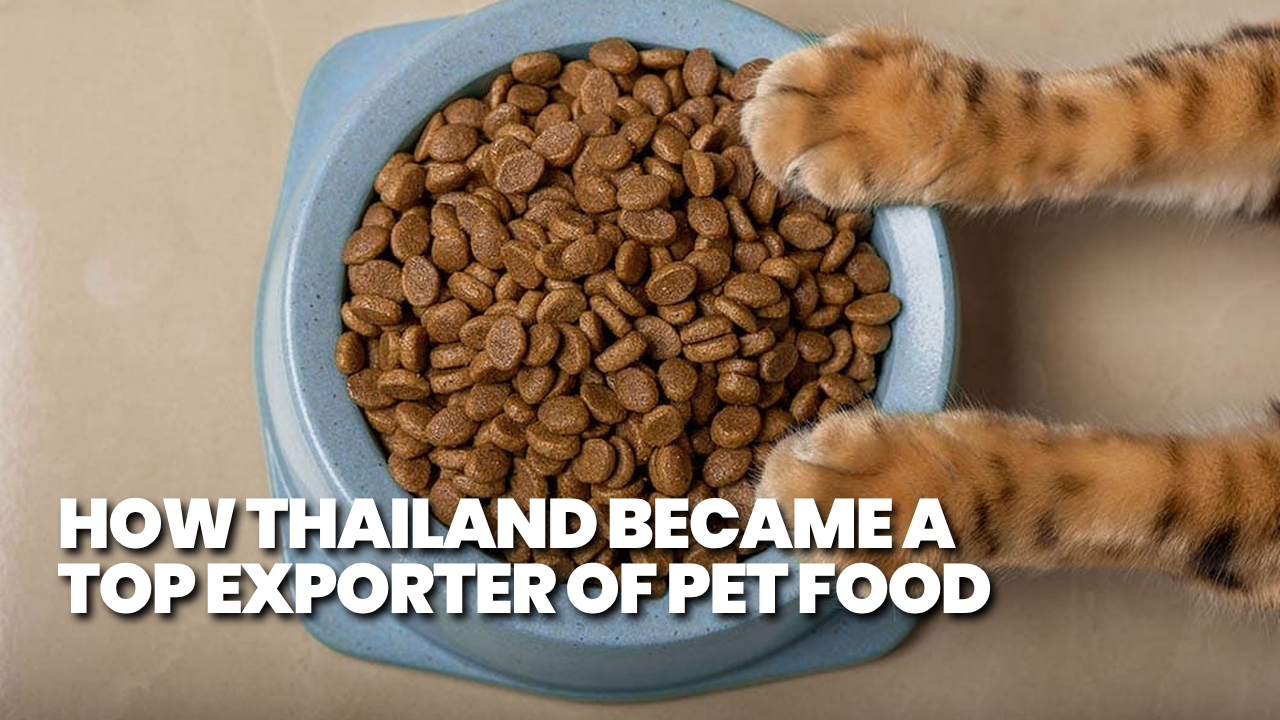
Everyone with a dog or cat wants the best for them, and food is a big part of that. The demand for high-quality, safe, and nutritious pet food has rapidly increased in recent years. A small section of local stores used to be in this area. Now it’s an international marketplace where brands from everywhere. Thailand is one of the biggest names in this business, and it sells food for dogs and cats all over Asia, Europe, and the US. Thailand became the world’s second-largest pet food exporter, with shipments valued at US$2.67 billion, up 29% from the previous year, and accounting for 10% of the international market share.
As a leading pet food exporter, Thailand has built its reputation through strong Thailand export growth, backed by advanced food manufacturing, strict quality standards, and a focus on new ideas. Thailand’s cat food is affordable but also safe, healthy, and full of different flavors. Because of this, more pet owners and pet food sellers are going to Thailand to find safe places to buy dog and cat food.
In this article, we’ll talk about how Thailand became a top exporter of pet food, what makes its goods stand out, and why demand for them throughout the international market is going up.
Why Thailand is now a world leader in pet food
Strong Performance in Exports
In the past few years, Thailand export of pet food has grown a lot, making it one of the world’s top exporters. Even though the economy is uncertain, the country has made steady progress, growing into important places like the US, Japan, and Europe.
Most Important Markets
Thai goods are primarily sold in the United States, Japan, Australia, Italy, and Malaysia. Also, more products are being exported to Taiwan and other Asian countries. Together, these countries account for most of Thailand’s worldwide petfood sales.
Thailand’s Key Export Markets
In 2024, the US continued to be the biggest buyer of Thai pet food, taking in 32.4% of all orders worth US$868.4 million, which was a huge 47% growth from the previous year. Other important places where Thailand sold dog and cat food were as follows.
- Japan: US$329.37 million, representing 12.3% of exports
- Australia: US$167.21 million, accounting for 6.2%
- Italy: US$164.94 million, also 6.2%
- Malaysia: US$138.18 million, or 5.2%
It also went up by 47% in shipments to the European Union, which reached US$349.58 million. The top buyers were Italy, Germany, Belgium, France, and the Netherlands. These numbers show that Thailand is becoming more important in the worldwide pet food market and that its high-quality goods are in high demand.
Innovation and Sustainability
Thailand’s focus on high-quality, healthy foods and sustainable production methods is one of its strengths. International demand for grain-free, organic, and functional petfood is on the rise, and Thai producers are capitalizing on this trend by introducing new product lines and eco-friendly packaging.
How Thailand Exports Dog and Cat Food Manufacturing Standards
Thai food producers are known for closely following international quality and safety rules. Pet food, both dry and wet, goes through a lot of checks to make sure it meets the regulations in every export market.
- High-performance supply chains
Thailand’s international success is helped by its well-developed logistics system. Raw materials like fishmeal, chicken, and grains are either found locally or brought in from other countries. These are then turned into finished goods and sent internationally via major ports.
- Agreements on Trade
Thailand profits from trade deals that make tariffs lower in many other countries. These deals make Thai products more competitive, which means they can get into new markets for a lower price.
- Concepts for Branding
In the pet food business, “Made in Thailand” has become an accepted label. To win over pet owners overseas, exporters stress the use of high-quality ingredients and certifications. To make getting into the market easier, many work with area distributors.
Also Read This: A Simple Guide: Custom Clearance Charges & Procedure in India
7 Practical Tips for New Pet food Exporters
If your business wants to start Petfood exporter, here are some things you can do.
1. Find out about market rules first
Before you ship, find out what the country you’re going to has to say about food safety and labels. Not following the rules can lead to expensive rejects.
2. Start small and grow
Start with just one or two places to make sure your supply chain works and that you can follow the rules before going internationally.
3. Create partnerships with distributors.
When you work with local importers or distributors, you can get your products to shops faster and earn customers’ trust.
4. Concentrate on the Health Advantages
People who own pets look for clear health benefits, such as “grain-free,” “supports digestion,” or “boosts immunity.” Use simple words.
5. Use packaging that looks good and lasts a long time.
First impressions are important. Eco-friendly, resealable, and aesthetically pleasing packaging can make a big difference in places where there is a lot of competition.
6. Use online advertising
Use social media, online ads, and pet owner communities to promote your brand story and build recognition internationally.
7. Visit expos and trade shows.
Pet food expos are great places to meet buyers, make connections, and show your goods directly to importers.
Wrapping It Up
As a major exporter of dog and cat food, Thailand export shows how important it is to combine quality, branding, and trade strategy. The country’s ability to adapt to changing international demands is a good example for all Pet food exporters.
To be successful as a new Pet food exporter, you need to start small, focus on high quality, and be able to change with the needs of different markets. Businesses can stay in the international pet food industry for a long time by using conventional methods and coming up with new ideas all the time.
FAQs
Because it sells safe, high-quality dog and cat food that is also affordable, the food is made with strict standards and modern equipment.
The United States, Japan, Australia, Italy, Malaysia, and some Asian countries like Taiwan buy the most.
It has a lot of different tastes, healthy recipes, and packaging that is good for the environment.
Also Checkout Our YouTube Channel: @limeinstituteofexportimport






